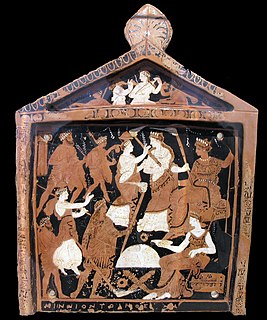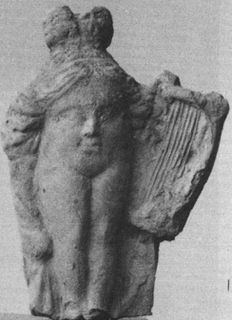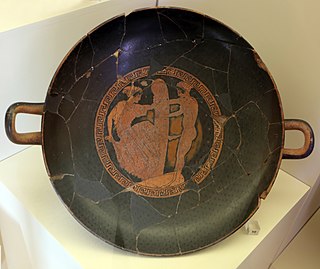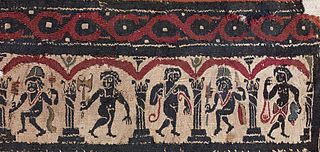Related Research Articles

In ancient Greek religion and mythology, Demeter is the Olympian goddess of the harvest and agriculture, presiding over grains and the fertility of the earth. She is also called Deo (Δηώ).

Hades, in the ancient Greek religion and myth, is the god of the dead and the king of the underworld, with which his name became synonymous. Hades was the eldest son of Cronus and Rhea, although this also made him the last son to be regurgitated by his father. He and his brothers, Zeus and Poseidon, defeated their father's generation of gods, the Titans, and claimed rulership over the cosmos. Hades received the underworld, Zeus the sky, and Poseidon the sea, with the solid earth, long the province of Gaia, available to all three concurrently. In artistic depictions, Hades is typically portrayed holding a bident and wearing his helm with Cerberus, the three-headed guard dog of the underworld, standing to his side.

In Greek mythology, Persephone, also called Kore or Kora, is the daughter of Zeus and Demeter. She became the queen of the Underworld after her abduction by Hades, the god of the underworld, with the approval of her father and brother-in-law, Zeus. The myth of her abduction, her sojourn in the underworld and her temporary return to the surface represents her functions as the embodiment of spring and the personification of vegetation, especially grain crops, which disappear into the earth when sown, sprout from the earth in spring, and are harvested when fully grown. In Classical Greek art, Persephone is invariably portrayed robed, often carrying a sheaf of grain. She may appear as a mystical divinity with a sceptre and a little box, but she was mostly represented in the process of being carried off by Hades.

Mystery religions, mystery cults, sacred mysteries or simply mysteries, were religious schools of the Greco-Roman world for which participation was reserved to initiates (mystai). The main characterization of this religion is the secrecy associated with the particulars of the initiation and the ritual practice, which may not be revealed to outsiders. The most famous mysteries of Greco-Roman antiquity were the Eleusinian Mysteries, which were of considerable antiquity and predated the Greek Dark Ages. The mystery schools flourished in Late Antiquity; Julian the Apostate in the mid 4th century is known to have been initiated into three distinct mystery schools—most notably the mithraists. Due to the secret nature of the school, and because the mystery religions of Late Antiquity were persecuted by the Christian Roman Empire from the 4th century, the details of these religious practices are derived from descriptions, imagery and cross-cultural studies. Much information on the Mysteries come from Marcus Terentius Varro.

The Eleusinian Mysteries were initiations held every year for the cult of Demeter and Persephone based at the Panhellenic Sanctuary of Eleusis in ancient Greece. They are the "most famous of the secret religious rites of ancient Greece". Their basis was an old agrarian cult, and there is some evidence that they were derived from the religious practices of the Mycenean period. The Mysteries represented the myth of the abduction of Persephone from her mother Demeter by the king of the underworld Hades, in a cycle with three phases: the descent (loss), the search, and the ascent, with the main theme being the ascent of Persephone and the reunion with her mother. It was a major festival during the Hellenic era, and later spread to Rome. Similar religious rites appear in the agricultural societies of the Near East and in Minoan Crete.

Dionysus is the god of the grape-harvest, winemaking, orchards and fruit, vegetation, fertility, insanity, ritual madness, religious ecstasy, festivity and theatre in ancient Greek religion and myth. He is also known as Bacchus, the name adopted by the Romans; the frenzy that he induces is bakkheia. As Eleutherios, his wine, music and ecstatic dance free his followers from self-conscious fear and care, and subvert the oppressive restraints of the powerful. His thyrsus, a fennel-stem sceptre, sometimes wound with ivy and dripping with honey, is both a beneficent wand and a weapon used to destroy those who oppose his cult and the freedoms he represents. Those who partake of his mysteries are believed to become possessed and empowered by the god himself.
In ancient Greek religion and mythology, Iacchus was a minor deity, of some cultic importance, particularly at Athens and Eleusis in connection with the Eleusinian mysteries, but without any significant mythology. He perhaps originated as the personification of the ritual exclamation Iacche! cried out during the Eleusinian procession from Athens to Eleusis. He was often identified with Dionysus, perhaps because of the resemblance of the names Iacchus and Bacchus, another name for Dionysus. By various accounts he was a son of Demeter, or a son of Persephone, identical with Dionysus Zagreus, or a son of Dionysus.
In Greek mythology, Minthe was a naiad nymph associated with the river Cocytus. She was beloved by Hades, King of the Underworld, and transformed into a mint plant by either his wife Persephone or his sister and mother-in-law Demeter.
In Greek Mythology, Eumolpus was a legendary king of Thrace. He was described as having come to Attica either as a bard, a warrior, or a priest of Demeter and Dionysus.
Pluto was the ruler of the underworld in classical mythology. The earlier name for the god was Hades, which became more common as the name of the underworld itself. In ancient Greek religion and mythology, Pluto represents a more positive concept of the god who presides over the afterlife. Ploutōn was frequently conflated with Ploutos, the Greek god of wealth, because mineral wealth was found underground, and because as a chthonic god Pluto ruled the deep earth that contained the seeds necessary for a bountiful harvest. The name Ploutōn came into widespread usage with the Eleusinian Mysteries, in which Pluto was venerated as both a stern ruler and a loving husband to Persephone. The couple received souls in the afterlife and are invoked together in religious inscriptions, being referred to as Plouton and as Kore respectively. Hades, by contrast, had few temples and religious practices associated with him, and he is portrayed as the dark and violent abductor of Persephone.
Fertility rites are religious rituals that are intended to stimulate reproduction in humans or in the natural world. Such rites may involve the sacrifice of "a primal animal, which must be sacrificed in the cause of fertility or even creation".

Hilda Doolittle was an American poet, novelist, and memoirist, associated with the early 20th-century avant-garde Imagist group of poets, including Ezra Pound and Richard Aldington. She published under the pen name H.D.

Baubo is an old woman in Greek mythology which appears particularly in the myths of the early Orphic religion. Known as the goddess of mirth, she is depicted as bawdy and sexually liberated, and is said to have jested with Demeter when that god was mourning the loss of her daughter, Persephone.
Melinoë is a chthonic nymph or goddess invoked in one of the Orphic Hymns and represented as a bringer of nightmares and madness. The name also appears on a metal tablet in association with Persephone. The hymns are of uncertain date but were probably composed in the 2nd or 3rd century AD. In the hymn, Melinoë has characteristics that seem similar to Hecate and the Erinyes, and the name is sometimes thought to be an epithet of Hecate. The terms in which Melinoë is described are typical of moon goddesses in Greek poetry.

In Greek mythology, Despoina was the daughter of Demeter and Poseidon and sister of Arion.

Haloa or Alo (Ἁλῶα) was an Attic festival, celebrated principally at Eleusis, in honour of Demeter, protector of the fruits of the earth, of Dionysus, god of the grape and of wine, and Poseidon, god of the seashore vegetation. In Greek, the word hálōs (ἅλως) from which Haloa derives means “threshing-floor” or “garden.” While the general consensus is that it was a festival related to threshing—the process of loosening the edible part of cereal grain after harvest—some scholars disagree and argue that it was instead a gardening festival. Haloa focuses mainly on the “first fruits” of the harvest, partly as a grateful acknowledgement for the benefits the husbandmen received, partly as prayer that the next harvest would be plentiful. The festival was also called Thalysia or Syncomesteria.

The cult of Dionysus was strongly associated with satyrs, centaurs, and sileni, and its characteristic symbols were the bull, the serpent, tigers/leopards, the ivy, and the wine. The Dionysia and Lenaia festivals in Athens were dedicated to Dionysus, as well as the phallic processions. Initiates worshipped him in the Dionysian Mysteries, which were comparable to and linked with the Orphic Mysteries, and may have influenced Gnosticism. Orpheus was said to have invented the Mysteries of Dionysus.

In Greek and Roman mythology, Aura is a minor deity, whose name means "breeze". The plural form, Aurae is sometimes found. According to Nonnus, Aura was the daughter of the Titan Lelantos and the mother, by Dionysus, of Iacchus, a minor deity connected with the Eleusinian mysteries, while Quintus Smyrnaeus makes the Aurae daughters of Boreas, the North-wind. Aurae was the title of a play by the Athenian comic poet Metagenes, who was contemporary with Aristophanes, Phrynichus, and Plato.
In the Dionysiaca of Nonnus, Lelantos, or Lelantus is the Titan father of the nymph Aura ("Breeze"), who was the mother, by Dionysus, of Iacchus, a minor deity connected with the Eleusinian Mysteries. Lelantos was married to the Oceanid Periboia, whom Nonnus seems to imply was Aura's mother, although elsewhere, he calls Aura the "daughter of Cybele".

The Exaltation of the Flower is the modern title given to an early Classical Greek marble fragment of a funerary stele from the 5th century BCE. It was discovered in 1863 by Léon Heuzey and Henri Daumet at a church in Farsala, Thessaly, Greece. Carved in bas-relief in the severe style, the extant upper fragment of the marble relief stele depicts two women holding what appear to be flowers or other objects. The work is held by the Louvre museum in the Department of Greek, Etruscan, and Roman Antiquities.
References
Citations
- ↑ Doolittle 1986, p. 305.
- ↑ Morris 1986, p. 511.
- 1 2 Sword 1995, p. 144.
- ↑ Holland 1989, p. 8.
- 1 2 3 4 Sword 1995, p. 147.
- ↑ Seed 1995, p. 17.
- ↑ Engel 1969, p. 518.
- ↑ Burnett 1989, p. 142.
- 1 2 3 4 Martz 1998, p. 87.
- ↑ Martz 1998, p. 88.
- ↑ Sword 2002, p. 121.
- ↑ Sword 2002, p. 120.
- ↑ Sword 2002, p. 125.
- ↑ Rosenmeier 1992, p. 80.
- ↑ Collecott 1999, p. 208.
- ↑ Burnett 1989, p. 138.
- ↑ "Eleusinian Mysteries: Secret ceremonies promising happiness". BBC. 28 January 2021. Retrieved 7 February 2022.
- ↑ Laster 2005, p. 183.
Bibliography
- Burnett, Gary Dean (1989). H.D. Between Image and Epic: The Mysteries of Her Poetics. UMI Research Press. ISBN 083572042X.
- Collecott, Diana (1999). H.D. and Sapphic Modernism 1910–1950. Cambridge University Press. ISBN 9780521550789.
- Doolittle, Hilda (1986). Louis Lohr Martz (ed.). Collected Poems 1912–1944. New Directions Publishing. ISBN 9780811223560.
- Engel, Bernard F. (1969). "H. D.: Poems That Matter and Dilutations". Contemporary Literature . 10 (4): 507–522. doi:10.2307/1207693. JSTOR 1207693.
- Holland, Norman N. (1989). Poems in Persons: An Introduction to the Psychoanalysis of Literature. Columbia University Press. ISBN 9780231923347.
- Laster, James (2005). Catalogue of Music for Organ and Instruments. Scarecrow Press. ISBN 9780810852990.
- Martz, Louis Lohr (1998). Many Gods and Many Voices: The Role of the Prophet in English and American Modernism. University of Missouri Press. ISBN 9780826211484.
- Morris, Adalaide (1986). "A Relay of Power and of Peace: H. D. and the Spirit of the Gift". Contemporary Literature . 27 (4): 493–524. doi:10.2307/1208493. JSTOR 1208493.
- Rosenmeier, Rosamond (1992). ""Fragrant Vine / From Barren Wood": H. D.'s Use of the Moravian Wounds Litany". Christianity and Literature. 42 (1): 69–84. doi:10.1177/014833319204200106. JSTOR 44312136.
- Seed, David (1995). "H.D. (Hilda Doolittle)". In Brian Docherty; Clive Bloom (eds.). American Poetry: The Modernist Ideal. Palgrave Macmillan UK. pp. 10–27. ISBN 9781349240579.
- Sword, Helen (1995). Engendering Inspiration: Visionary Strategies in Rilke, Lawrence, and H.D. University of Michigan Press. ISBN 9780472105946.
- Sword, Helen (2002). Ghostwriting Modernism. Cornell University Press. ISBN 9781501717666.